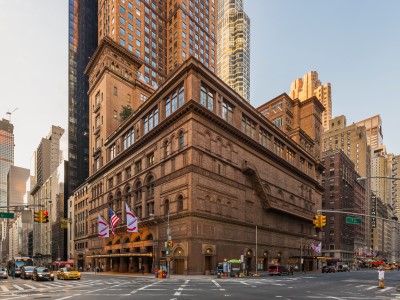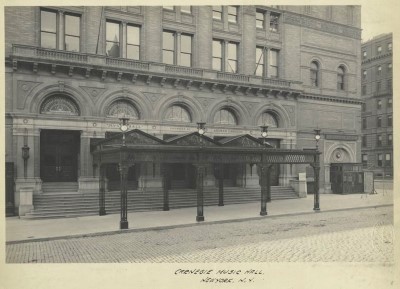1908. Carnegie Hall.
Carnegie Hall is a concert venue in Midtown Manhattan in New York City, United States, located at 881 Seventh Avenue, occupying the east side of Seventh Avenue between West 56th Street and West 57th Street, two blocks south of Central Park.
Designed by architect William Burnet Tuthill and built by philanthropist Andrew Carnegie in 1891, it is one of the most prestigious venues in the world for both classical music and popular music. Carnegie Hall has its own artistic programming, development, and marketing departments, and presents about 250 performances each season. It is also rented out to performing groups. The hall has not had a resident company since 1962, when the New York Philharmonic moved to Lincoln Center’s Philharmonic Hall (renamed Avery Fisher Hall in 1973 and David Geffen Hall in 2015).
Carnegie Hall is one of the last large buildings in New York built entirely of masonry, without a steel frame; however, when several flights of studio spaces were added to the building near the turn of the 20th century, a steel framework was erected around segments of the building. The exterior is rendered in narrow Roman bricks of a mellow ochre hue, with details in terracotta and brownstone. The foyer avoids typical 19th century Baroque theatrical style with the Florentine Renaissance manner of Filippo Brunelleschi’s Pazzi Chapel: white plaster and gray stone form a harmonious system of round-headed arched openings and Corinthian pilasters that support an unbroken cornice, with round-headed lunettes above it, under a vaulted ceiling. The famous white and gold auditorium interior is similarly restrained.
Carnegie Hall is named after Andrew Carnegie, who funded its construction. It was intended as a venue for the Oratorio Society of New York and the New York Symphony Society, on whose boards Carnegie served. Construction began in 1890, and was carried out by Isaac A. Hopper and Company. Although the building was in use from April 1891, the official opening night was May 5, with a concert conducted by maestro Walter Johannes Damrosch (1862-1950)Walter and great Russian composer Pjotr Iljitsj Tchaikovsky (1840-1893).
Originally known simply as “Music Hall” (the words “Music Hall founded by Andrew Carnegie” still appear on the façade above the marquee), the hall was renamed Carnegie Hall in 1893 after board members of the Music Hall Company of New York (the hall’s original governing body) persuaded Carnegie to allow the use of his name.
Several alterations were made to the building between 1893 and 1896, including the addition of two towers of artists’ studios, and alterations to the smaller auditorium on the building’s lower level.

1908. Carnegie Hall.
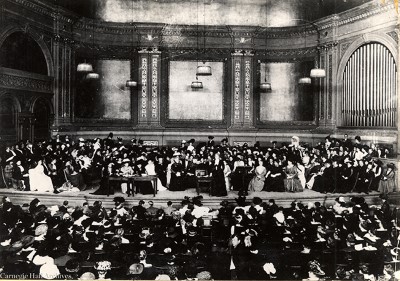
1909. Carnegie Hall.
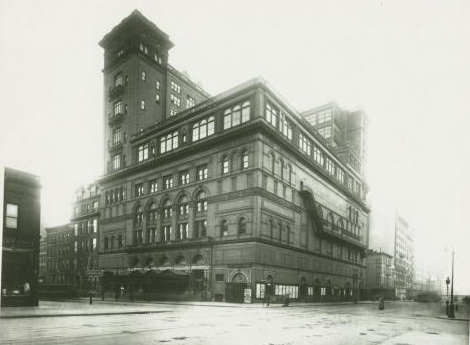
1910. Carnegie Hall.
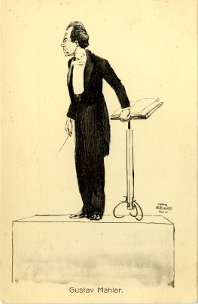
Carnegie Hall. Mahler postcard.
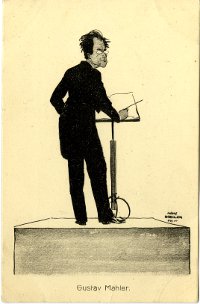
Carnegie Hall. Mahler postcard.
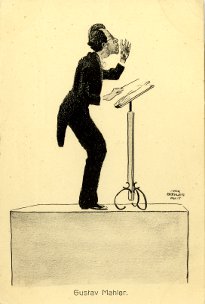
Carnegie Hall. Mahler postcard.

1975. Mahler Festival, Boulez, Leinsdorf, Levine, New York Philharmonic Orchestra (NYPO/NPO), Carnegie Hall.
